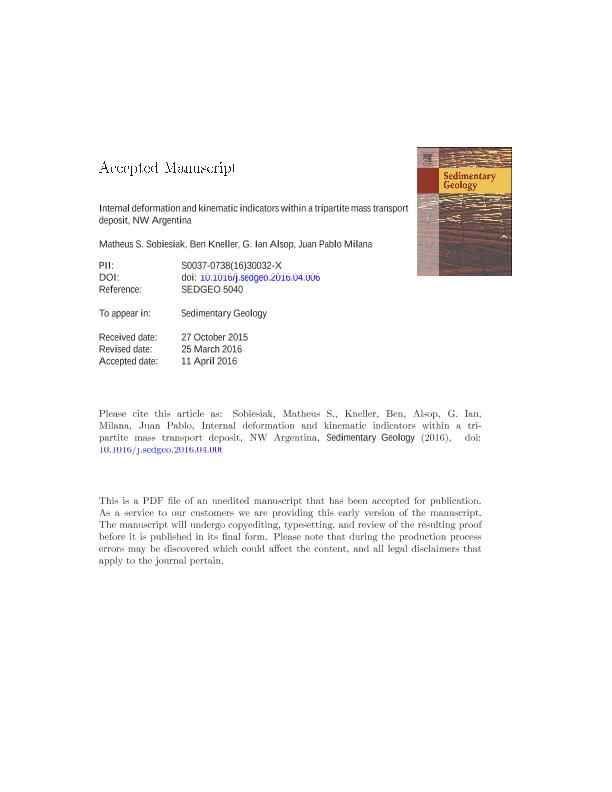Artículo
Internal deformation and kinematic indicators within a tripartite mass transport deposit, NW Argentina
Fecha de publicación:
10/2016
Editorial:
Elsevier Science
Revista:
Sedimentary Geology
ISSN:
0037-0738
Idioma:
Inglés
Tipo de recurso:
Artículo publicado
Clasificación temática:
Resumen
The role of mass transport deposits (MTDs) in redistributing sediment from the shelf-break to deep water is becoming increasingly apparent and important in the study of basins. While seismic analysis may reveal the general morphology of such deposits, it is unable to provide information on the detailed geometry and kinematics of gravity-driven transport owing to the limits of seismic resolution. Outcrop analysis of ancient MTDs may therefore provide critical observations and data regarding the internal deformation and behavior during slope failure. One such field area where geometry and kinematics are clearly exposed is Cerro Bola in the Paganzo Basin of northwestern Argentina. This 8 km strike section exposes a mid to late Carboniferous succession, comprising fluvio-deltaic sediments, turbidites and MTDs. Our work focuses on the main MTD that is up to 180 m thick and is characterized by a silty matrix, containing sandstone blocks and siltstone rafts. Although we consider a single slope failure as the most likely scenario, a possible double failure might also explain the occurrence of a folded turbidite marker in the upper zone of the MTD. The MTD is host to a variety of deformational features such as folding, boudinage, shear zones, allochthonous strata, and secondary fabrics among others. These deformational features vary in intensity, scale and style, both vertically and laterally across the deposit. The vertical variation is the most notable, and the entire deposit can be subdivided into lower, middle and upper zones according to variations in texture and structures, including sandstone blocks, sand streaks and blebs in the matrix, folding on a variety of scales, and shear zones. The middle part of the MTD is characterized by the abundance of siltstone rafts. Various models are proposed for the origin of blocks and rafts within the MTD: erosion of underlying strata; fragmentation of the original protolith; or a mixture of both. Significantly, specific strain cells occur around the blocks, and so the kinematics of deformation structures in the matrix of the MTD are very largely governed by their proximity and position relative to blocks, and may not relate to the overall kinematics of the MTD. This casts serious doubt on the ability to interpret overall movement directions from core or dip-meter data in the subsurface.
Archivos asociados
Licencia
Identificadores
Colecciones
Articulos(CIGEOBIO)
Articulos de CENTRO DE INVESTIGACIONES DE LA GEOSFERA Y BIOSFERA
Articulos de CENTRO DE INVESTIGACIONES DE LA GEOSFERA Y BIOSFERA
Citación
Sobiesiak, Matheus S.; Kneller, Ben; Alsop, G. Ian; Milana, Juan Pablo; Internal deformation and kinematic indicators within a tripartite mass transport deposit, NW Argentina; Elsevier Science; Sedimentary Geology; 344; 10-2016; 364-381
Compartir
Altmétricas




